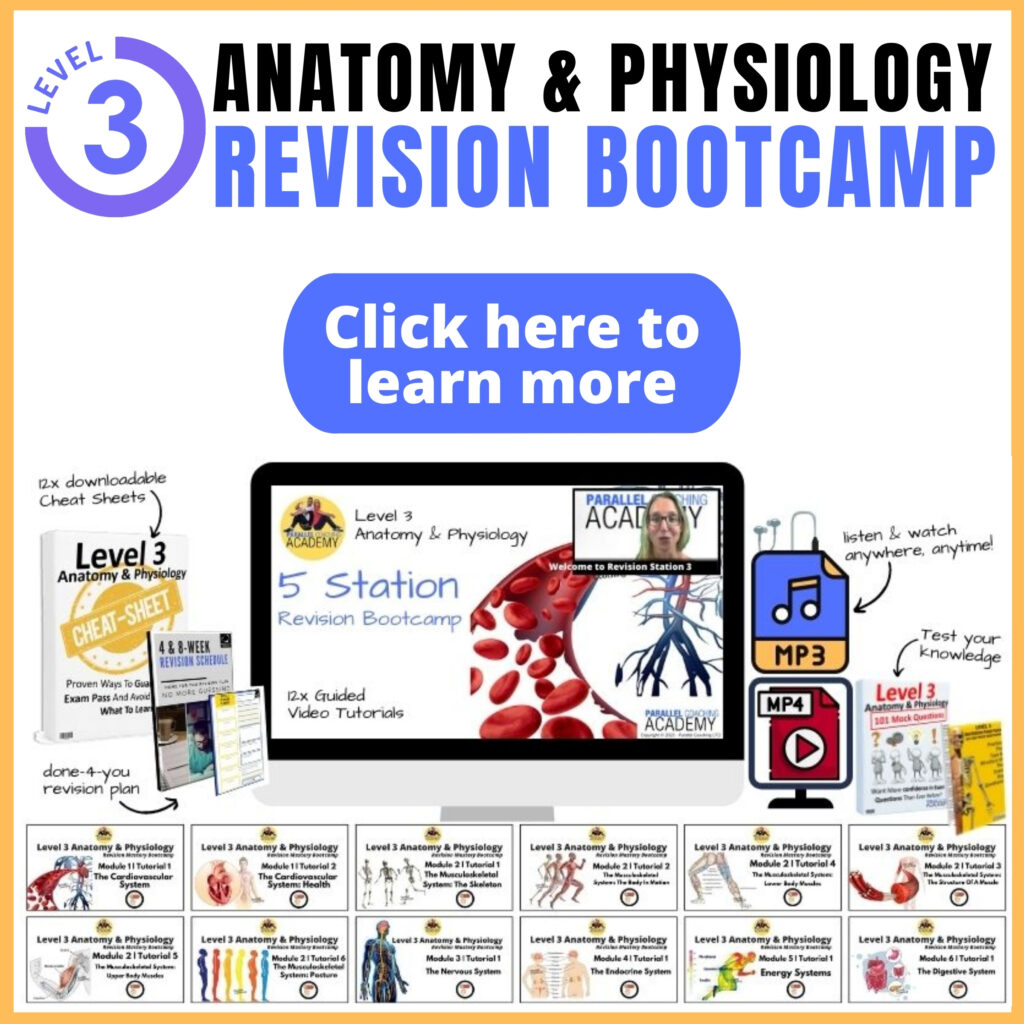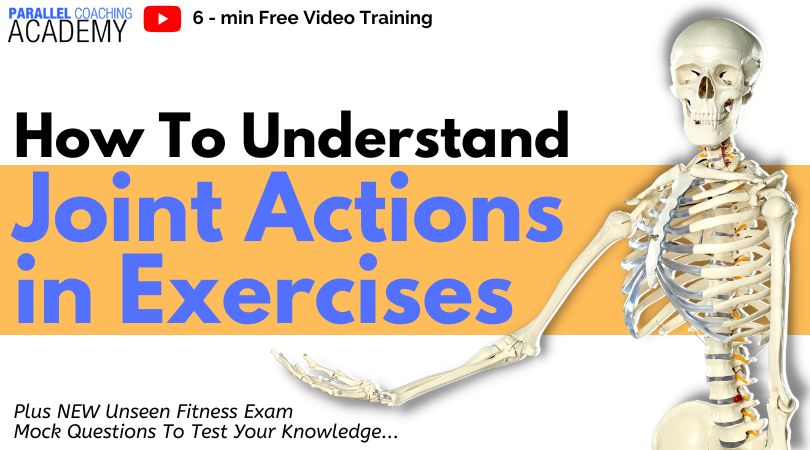Today’s video and blog will help you understand joint actions in exercises. This is perfect for you if you are a trainee personal trainer, and currently trying to make sense of resistance training systems and joint actions.
Here you’ll link your anatomy and physiology knowledge of joint actions to exercise prescription and client planning.
Watch the 6-minute video tutorial below, and then uncover the 4 simple steps to Understand Joint Actions in Exercises. Plus three mock questions to test your knowledge at the end of the blog.
Watch How To Understand Joint Actions in Exercises
Why do FITPROs find joint actions in exercises so difficult?
If you find this tricky, don’t worry you are not alone…
Trainee and qualified fitness professionals, often find joint actions in exercises challenging. Here’s why…
Firstly, it requires a deep understanding of anatomy and physiology. You need to understand joint types, muscles, phases of movement and joint actions.
That’s why learning anatomy and physiology isn’t just about remembering key concepts. There has to be depth to the knowledge and understanding.
This depth allows you to piece together each part of the anatomy knowledge and apply it to an exercise.
There are several steps to work out the joint actions in any exercise. We’ll explore these steps now:
Step 1 = The concentric phase of the exercise.
You need to pick just one exercise.
This may sound silly but most overwhelm comes from people trying to think of multiple examples at once. so complete the process with just one simple exercise… like a squat for example.
Now identify the concentric phase…
Every movement and exercise has a lifting and a lowering phase.
For example, the squat has the lowering phase when you move from standing and lower down into tripled flexed position at the bottom of the movement.
The lifting phase is then lifting from this position, against the force of gravity, to standing again.
The Concentric Phase of a Movement = The Lifting Phase, whereby the load goes towards the Clouds against gravity (c for concentric, c for clouds). Note, the load is your own body weight in a press-up, or the dumbbell in a bicep curl, or the weight stack on a Lat Pull Down machine.
The Eccentric Phase of a Movement = The Lowering Phase, whereby the load goes towards the Earth with gravity (e for eccentric, e for earth). Note, this phase feels easier, because we are no longer pushing the load against the force of gravity, instead gravity is helping the lowering phase.
Step 2 = Identify the joints moving in the Exercise
Now, we need to take our understanding of the Concentric Phase of movement and apply it to the exercise.
Let’s use a squat as the example
The squat exercise could use several different pieces of equipment, but it will give you the same answer.
- Bodyweight squat
- Back squat
- Goblet squat
- Front squat
When you analyse the exercise and watch it in the concentric phase, you can see that three joints are moving:
- Hips
- Knees
- Ankles
- (The spine is usually still – however, if the client’s spine is moving, consider this too)
Step 3 = Identify the joint actions that happen in the concentric phase
Now you know which joints are moving. You need to look at those joints during the concentric (lifting phase) and apply your joint action knowledge.
What is happening at each joint in the concentric phase? Our example of the squat is:
- Hips = Hip Extension
- Knees = Knee Extension
- Ankles = Plantarflexion
Notice we don’t mention the joint actions during the eccentric phase, as this is the lowering phase where the prime mover is eccentrically contracting to create the opposite action.
Instead just use discuss the joint action in the concentric phase, as this is the lifting phase where the prime mover is concentrically contracting to create the primary actions.
NOTE: be really astute as to which joint action is actually happening, a small change in the angle of the joint, can change the plane of movement and the joint action.
For example –
- a wide grip barbell shoulder press will create Abduction at the shoulder, and shoulder joint action is in the frontal plane
- a narrow neutral grip shoulder press with a weight plate (or two dumbbells) will create shoulder flexion, and the shoulder joint is moving in the sagittal plane
Step 4 = Associated Muscle Actions
Now you Understand Joint Actions in Exercises you can take it one step further, and work out the muscle that is working in that exercise.
in our squat example:
- Hips = Hip Extension = Glutes and hamstrings
- Knees = Knee Extension = Quadriceps
- Ankles = Plantarflexion = Gastrocnemius
So now you know the prime movers of the exercise based purely on which joint actions are taking place in the concentric phase.
Test your knowledge with today’s mock questions:
[NOTE: The answers are below the 3rd question]
Q1: What Joint Action Occurs in The Eccentric Phase of the Biceps Curl Exercise?
A. Elbow Flexion
B. Shoulder Flexion
C. Elbow Extension
D. Shoulder Extension
Q2: What Joint Action Occurs in a Lateral Raise?
A. Elbow Extension
B. Elbow Flexion
C. Shoulder Lateral Flexion
D. Shoulder Abduction
Q3: Which muscle creates the joint action of knee flexion?
A. Quadriceps
B. Hamstrings
C. Biceps Brachii
D. Triceps Brachii
Answers to the mock questions are :
Question 1= C, Question 2 = D, Question 3 = B
If you want more mock questions like this, then you can download more Free Mock Questions: DOWNLOAD NOW
Need More Help with Your Level 3 Anatomy Revision?
For Trainee FITPROS Taking Their L3 Anatomy & Physiology Exam.
Learn, Revise & Pass Your Level 3 Anatomy & Physiology Exam In Under 10-hours
(Without Having To Spend Hours Revising Or Feeling Overwhelmed)
If you want to get your revision structured, learn everything you need to know and feel confident on exam day, then click the link below:

Dedicated to More
Hayley “Understand Joint Actions in Exercises” Bergman
Parallel Coaching
P.S. You can also find us on the following platforms:
Instagram: Follow Now
Facebook: Like Our Page
Twitter: Tweet Us
YouTube: Subscribe Here
Joint Action Blogs: HERE

